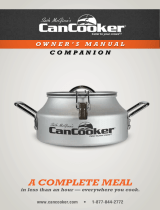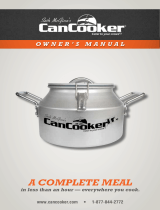TheCampLab.com CanFire Operating instructions
- Type
- Operating instructions

page 1
This wonderful product is safer than a regular campfire in many ways – it’s often even
allowed during burn bans. But, like a campfire, it is inherently dangerous and you
must take responsibility to learn its special hazards so you can operate it safely. Read
this manual, understand it, ask us about anything you’re unclear about, and keep it handy in
the lid pocket of the storage bag.
Operating Manual
for the CanFire™ portable campfire
The rock-bottom basics of operation are these:
* To turn ON: light the wick
* To continue: add wax occassionally
* To turn OFF: put the lid on
But if that’s all you know, you could get a nasty surprise one day. You need to know a
little more. Comparing the CanFire™ to a regular campfire:
The CanFire™ is NOT like a campfire in this way:
1) CanFires™ are extinguished instantly by putting the lid on – NEVER with
water! see next page for details
2) You can’t tell if a CanFire™ is hot or cold when it’s closed.
3) The CanFire™ operates with blazingly hot liquid wax. So knocking it over can
result in serious burns. see next page for more details
Your CanFire should come with these components:
1 CanFire™ can filled with 1800 grams of wax (4lbs)
1 Storage bag
2 Silicone pot holders
possibly:
1 trivet
1 tongs

page 2
#2 Consider location and context before starting a CanFire™
#3 Flame On! - light the wick at the ends
Locate the CanFire™ like you would a campfire:
• Use OUTDOORS only!
• In a level clearing, well away from burnables above,
to the side or under it. An old fire ring is often ideal.
• Do NOT put it on a table. Like a campfire, the pot
gets really hot underneath – a wood picnic table will
burn, a glass patio table will shatter.
• Keep it low to the ground. Unlike a campfire it can
accidentally be knocked over and spilled.
Context is really important:
• KEEP CHILDREN WELL AWAY – No horseplay can be
allowed near a CanFire™.
• Brief EVERYONE on saftey and warn against trying to
put it out with water.
• Consider not using the CanFire™ that night if the crowd you’re with is likely to be rowdy.
SEVERE burns are far too high a price for drunken partying. You’ll get the “Best camp
toy” award some other night, trust us (and by the way it’s NOT A TOY)
• If there’s a breeze, you might prop the lid against the side as a small windbreak. This
also makes the flame swirl in a nice way. The lid will get sooty and hot but it won’t hurt it.
• It takes about a half an hour to really get going.
SEVERE BURN HAZARD
No Skin Contact with Wax!
SEVERE BURN HAZARD
Keep Children Away!
FIREBALL HAZARD
Keep Water Out!
The wax inside the CanFire™ reaches temperatures of
over 600˚F. This is MUCH hotter than normal cook-
ing temperatures you’re familiar with. It will cause
SEVERE 3rd DEGREE burns if it touches skin.
Keep liquids OUT! Spilling water in, or pouring
water onto a hot CanFire™ CAUSES A VIOLENT
ERUPTION OF HOT WAX and a LARGE FIREBALL
— The fireball is big – possibly setting fire to things
that were out of reach before, like you.
— The hot wax splatter zone is several feet - well
within reach of friends who might be sitting
around it. At the least, their clothes will be ruined.
— No peeing on a CanFire™!
— Keep Rain Out!
#1 Two supremely important warnings
CARBON MONOXIDE HAZARD
Outdoor Use Only!
WARNING
OPEN FLAME
Keep Burnables Away!

page 3
• Add wax to keep the CanFire™ going. Don’t splash. Use the tongs.
• Regulate the CanFire’s flame by adjusting the wax level:
— A half inch of wick showing above the wax makes a small flame (roughly 2-10”.
— One inch to one and a half inches of wick showing gives a nice balance
between flame size, 8-18”, and wax consumption – about a pound per hour.
— Running a CanFire™ with two inches of wick showing or more makes the largest
flames and makes the bottom of the pot extremely hot. It also about doubles the
rate of wax use to roughly two pounds per hour.
* Sadly, toasting marshmallows on a CanFire™ is not a good idea. The flame is very
sooty and it makes the marshmallow taste like wax.
* Add scented wax for effect. Citronella keeps away mosquitos. “Spruce” is a lovely
evergreen forest fragrance. “Campfire” scent is always amusing
* To prevent melting in a hot car, the CanFire™ uses high melt temperature paraffin
wax (160˚F, 70˚C, often sold as “Hurricane candle” wax). Using other waxes
could cause faster or slower burning. We sell bags of the right wax that are compe-
tively priced and conveniently shaped.
• When moving the CanFire, put it out first (put the lid
on), then use the potholders to latch the lid locks and
hold onto the side handles.
• Never leave a lit CanFire™ unattended. If you need to
briefly leave it, put it out with the lid, lock it and put it
somewhere safe and out of traffic. Remember, once the lid is on, it’s hard to tell if
it’s hot.
* Sooty wax is almost impossible to clean off of clothes, objects or the ground. It
makes a real mess of a campsite so please be careful. It’s about a million times
dirtier than littering.
#5 Putting it out
• Put the lid on. NEVER use water!
Use tongs or pot holders if the lid is hot.
• Lock the lid on and make sure that it’s put safely out of
traffic. Note that the lid seal is NOT LEAKPROOF.
#4 Ongoing operation - fiberglass wick lasts forever
#6 Transporting — only when cool!
• NEVER transport, a hot CanFire™. The outside can burn and melt your gear, maybe even
start a fire or burn you or others in the event of an accident.
• A CanFire™ usually takes an hour to an hour and a half to cool enough to transport. If it’s
too hot to touch it’s too hot to travel.
* If you travel while the wax is still partly liquid, it will slosh around inside, mangle the
wick and coat the inside so the lid is stuck on. Big mess.
— Don’t use it in the morning if you’re traveling soon.
• Lock the lid on while cooling and transporting. Note that the seal is NOT LEAKPROOF.
BURN HAZARD
Locked Lid Can Leak!
FIREBALL HAZARD
Keep Water Out!

page 4
#7 Maintenance and general information
CLEANING the CanFire™:
• At some point you may find the collection of burnt bugs and sooty wax inside the
CanFire warrants removal. One simple way to do this is:
Let the wax burn down most of the way. Put the fire out with the lid. Let it
cool a few minutes. Take off the now-hot lid with a potholder or tongs.
Pick up the CanFire with the potholders and pour the wax and debris into
a container that won’t melt, like a paper cup or bowl. Don’t splash and
don’t even try to get the insides any cleaner.
• Add new wax and melt it using the techniques below.
NEVER HEAT WAX DIRECTLY — use an oven or a double-boiler on a stove. The wax
must not be allowed to get much over it’s melting point because the hotter it gets, the
more wax vapor it gives off – which is flammable. FAILURE to prevent over-
heating risks burning your house down.
NOTE too that the specific temperatures in these directions only apply to the
IGI-1260, 160F˚ melt point wax that we use in the CanFire™.
Low Heat Oven: Take off the CanFire’s lid and put it in an oven at 200˚F
(95˚C) DO NOT LEAVE UNATTENDED.
Double Boiler: Put a pan on the stove that is amply sized to fit the CanFire base.
Put an inch or two of water in the pan. Put the CanFire into the water and take off the
lid. It might float if there’s not much wax in it, that’s OK. Boil lightly until the wax is
melted. DO NOT LEAVE UNATTENDED and DO NOT LET THE PAN RUN DRY.
• Cleaning the outside is best done with a paper towel and paint thinner. Content
yourself with just getting off superficial wax and grime. Don’t try to make it clean like
a food pot. Use all normal paint thinner preautions.
Removing Water from a CanFire™ is a pain (it sinks to the bottom)
You can use the low-heat oven techniqe above to evaporate water caught inside.
Depending on how much is there, it could take up to an hour.
Note on BURN BANS:
One of the best features of the CanFire™ is that, many times, you can use a CanFire™
when campfires are banned. During burn bans, seek permission to use the CanFire™.
NEVER disobey an authority even if they’re being unreasonable. Nine times out of
ten, humor and respect will get you what you want. We even put the words “ON”
and “OFF” on the lid in case the rules say “it needs to have an ON/OFF knob.”
Literally, the entire lid is an ON/OFF knob.
Still have questions? Email [email protected]
Lost manual? Email [email protected] for a free replacement
Ha-ha, little joke. How can you remember to email for a new manual if the email address is on the
lost manual? Yes but maybe I can get you to remember that you CAN GET a new manual from the
website if I can trick you into reading something memorable – Bwa-ha-ha-ha-ha, like this perhaps?
-
 1
1
-
 2
2
-
 3
3
-
 4
4
TheCampLab.com CanFire Operating instructions
- Type
- Operating instructions
Ask a question and I''ll find the answer in the document
Finding information in a document is now easier with AI
Other documents
-
 Pit Boss PB340 Owner's manual
Pit Boss PB340 Owner's manual
-
 CanCooker G15-2016 Operating instructions
CanCooker G15-2016 Operating instructions
-
Sharper Image Fastest Heating Portable Wood BBQ Grill Owner's manual
-
 Hasty-Bake Suburban User manual
Hasty-Bake Suburban User manual
-
 CanCooker JR-001 Operating instructions
CanCooker JR-001 Operating instructions
-
Barbecook 223.0229.000 Datasheet
-
 Whirley Pop 26117 Operating instructions
Whirley Pop 26117 Operating instructions
-
 Wabash Valley Farms 37027 Operating instructions
Wabash Valley Farms 37027 Operating instructions
-
Jackson Grills PATIO FIRE Owner's manual
-
Villaware 8-280 User manual









